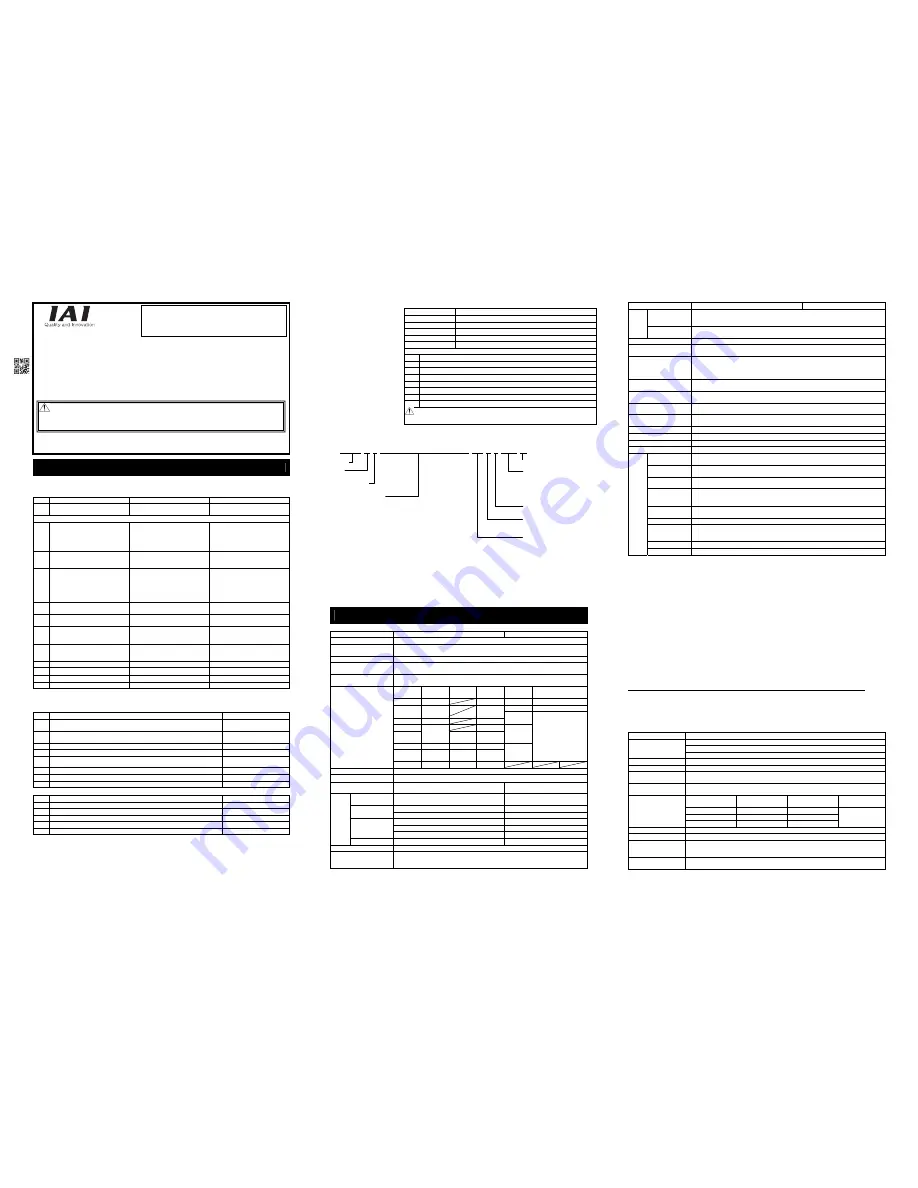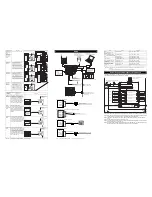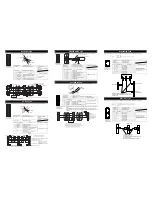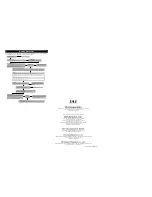
MSEP
First Step Guide
Fourth Edition
Thank you for purchasing our product.
Make sure to read the Safety Guide and detailed Instruction Manual (DVD) included with the product in addition to this First
Step Guide to ensure correct use.
This Instruction Manual is original.
•
Using or copying all or part of this Instruction Manual without permission is prohibited.
•
The company names, names of products and trademarks of each company shown in the sentences are registered
trademarks.
Product Check
This product is comprised of the following parts if it is of standard configuration.
If you find any fault in the contained model or any missing parts, contact us or our distributor.
1. Parts
No. Part
Name
Model
Remarks
1 Controller
Main
Body
Refer to “How to read the model
plate”, “How to read the model No.”
Accessories
2 Power
Connector
FKC2.5HC/4-ST-5.08
(Supplier : PHOENIX CONTACT)
Recommended Cable Size
•
Control Power Supply
0.5 to 0.3mm
2
(AWG20 to 22)
•
Motor Driving Power Supply
2.5 to 0.5mm
2
(AWG12 to 20)
3
External Brake Input Connector
FMCD1.5/5-ST-3.5
(Supplier : PHOENIX CONTACT)
Recommended cable size
0.5 to 0.2mm
2
(AWG20 to 24)
4
Drive Cutoff/Emergency Stop Input
Connector
FMCD1.5/8-ST-3.5
(Supplier : PHOENIX CONTACT)
Recommended Cable Size
•
Emergency Stop
0.5 to 0.2mm
2
(AWG20 to 24)
•
Motor Power External Input
1.25 to 0.5mm
2
(AWG16 to 20)
5
System I/O Connector
FMCD1.5/4-ST-3.5
(Supplier : PHOENIX CONTACT)
Recommended cable size
0.5 to 0.2mm
2
(AWG20 to 24)
6
I/O Flat Cable (For PIO Type)
CB-MSEP-PIO***
***shows the cable length
(Example) *** : 020 = 2 [m]
7
CC-Link Connector
(For CC-Link Type)
MSTB2.5/5-ST-5.08 ABGY AU
(Supplier : PHOENIX CONTACT)
Terminal Resistance (130
Ω
1/2W,
110
Ω
1/2W)
enclosed one unit each
8
DeviceNet Connector
(For DeviceNet Type)
MSTB2.5/5-ST-5.08 ABGY AU
(Supplier : PHOENIX CONTACT)
Prepare a terminal resistor separately
if this controller is to be allocated at
the terminal.
9
Absolute Battery Box (Option)
MSEP-ABU (Battery AB-7)
For Simple Absolute Type
10
First Step Guide
11
Instruction Manual (DVD)
12 Safety
Guide
2. Teaching Tool (Please purchase separately)
A teaching tool such as PC software is necessary when performing the setup for position setting, parameter setting, etc.
that can only be done on the teaching tool.
Please prepare either of the following teaching tools.
No. Part
Name
Model
1
PC Software
(Includes RS232C Exchange A Peripheral Communication Cable)
RCM-101-MW
2
PC Software
(Includes USB Exchange A USB Cable + Peripheral Communication Cable)
RCM-101-USB
3
Teaching Pendant (Touch Panel Teaching)
CON-PTA
4
Teaching Pendant (Touch Panel Teaching with deadman switch)
CON-PDA
5
Teaching Pendant
(Touch Panel Teaching with deadman TP Adapter (RCB-LB-TG))
CON-PGA
6
Teaching Pendant (Touch Panel Teaching)
TB-01
7
Teaching Pendant (Touch Panel Teaching with deadman switch)
TB-01D
8
Teaching Pendant (Dead man’s switch right mounted touch panel teaching)
TB-01DR
3. Instruction manuals related to this product, which are contained in the instruction manual (DVD).
No. Name
Manual
No.
1
MSEP Controller Instruction Manual
ME0299
2
PC Software
RCM-101-MW/RCM-101-USB Instruction Manual
ME0155
3
Touch Panel Teaching CON-PTA/PDA/PGA Instruction Manual
ME0295
4
Touch Panel Teaching TB-01/TB-01D/TB-01DR Instruction Manual
ME0324
5
XSEL controller RC Gateway Function Instruction Manual
ME0188
4. How to read the model plate
Model
→
MODEL MSEP-C-5-20PI-N-42PI-PI-10I-20ILA-DV-2-0-ABU
Serial number
→
SEREIAL No.
SI-E18392
Manufactured date
→
PRODUCT DATE
2012/02/01
Manual No.
→
MANUAL No.
ME0299
CP INPUT
DC24V 2.0A
Input power supply
→
MP INPUT
DC24V 7.6A
AXIS No. /OUTPUT
0
0-24Vac 3ph 0-333Hz 1.0A
1
2
0-24Vac 3ph 0-333Hz 2.0A
3
0-24Vac 3ph 0-333Hz 2.0A
4
0-24Vac 3ph 0-333Hz 1.3A
5
0-24Vac 3ph 0-333Hz 1.3A
6
Information of the
connected axes
→
(Axis No. 0 to 7)
7
CAUTION: Connect the wiring correctly and properly.
use IAI Corporation specified cables.
Made In Japan
5. How to read controller model code
(Example) Consists of 5 axes: Axis No.0=pulse motor type, Axis No.2,3=servo motor type, Axis No.4=No connected axis and Axis
No.1=Ineffective axis
M S E P - C - 5 - 2 0 P W A I - P W A I - 1 0 I - 2 0 I - N - D V - 2 - 0 - A B U - * *
Basic Specifications
List of Specifications
Specification Item
Driver for Servo Motor
Driver for Pulse Motor
Number of Controlled Axes
8 axes MAX.
Control/Motor Power Supply
Voltage
24V DC
±
10%
Brake Power Supply
0.15A × Number of axes
Control Power Current
Consumption
0.8A
Control Power In-Rush
Current
MAX. 5A 30ms or less
Motor Type
Rated
Low power
MAX.
(Note 1)
Motor
Flange Size
MAX.
(Note 2)
2W
0.8A
4.6A
20P 2.0A
28P 2.0A
3W (RCD)
0.7A
1.5A
5W
1.0A
6.4A
35P
10W (RCL)
6.4A
10W
(RCA/RCA2)
1.3A
2.5A 4.4A
42P
20W
1.3A
2.5A
4.4A
20W
(20S Type)
1.7A 3.4A 5.1A
56P
2.0A
(High output invalid)
3.5A (Rated) /
4.2A (MAX.)
(High output valid)
(Note 4)
Motor Current Consumption
30W
1.3A
2.2A 4.4A
Motor Power In-Rush Current
Number of slots × MAX. 10A 5ms or less
Heat Generation
26W Max.
Control System
Vector control (Rectangular waveform drive only for
3W of the motor type)
Weak field-magnet vector control
RCA,
RCP2 to RCP5
All Types
800Pulse/rev
RCA2-
□□□
N 1048Pulse/rev
RCA2
Except for RCA2-
□□□
N 800Pulse/rev
RA1L • SA1L • SA4L • SM4L
715Pulse/rev
RA2L • SA2L • SA5L • SM5L
855Pulse/rev
RCL
RA3L • SA3L • SA6L • SM6L
1145Pulse/rev
Encod
e
r Resol
u
tion
RCD All
Types
400Pulse/rev
Actuator Cable Length
MAX. 20m (Note) 10m maximum for Simple Absolute type
Serial Communication
Interface
(SIO Port: Only for teaching)
RS485 1CH (based on Modbus Protocol) Speed 9.6 to 230.4kbps
Specification Item
Driver for Servo Motor
Driver for Pulse Motor
PIO Type
PIO Type:Signal I/O dedicated for 24V DC (to be selected when purchased NPN/PNP)
Number of max. input: 4 points per axis, Number of max. output: 4 points per axis
Cable length MAX. 10m
Exter
n
al
Inter
face
Field Network Type
DeviceNet, CC-Link, PROFIBUS-DP, CompoNet, EtherNet/IP, EtherCAT
(Reference) An operation by RC Gateway Function is available.
Data Setting and Input
PC Software, Touch Panel Teaching, Gateway Parameter Create Tool
Data Retention Memory
Position data and parameters are saved in the nonvolatile memory.
(There is no limitation in number of writing)
Number of Positioning Points
PIO Type: 2 or 3 points
Field Network Type: 256 points (There is no limit for simple direct and direct indication modes)
(The number of positioning points differs depending on the operation mode select by the
parameter setting.)
LED Display
(Mounted on Front Panel)
8 LED lamps for driver status display (for each driver board)
Status LED 4 points (PIO Type), 7 points (Field Network Type)
Electromagnetic Brake
Compulsory Release
Brake release available for each axis by compulsory release signal input (24V DC input)
Protective functions
(Note3)
Overcurrent Protection (Equipped with a built-in cutoff circuit using a semiconductor for each
slot)
Protection Function against
Electric Shock
Class I basic insulation
Insulation Resistance
500V DC 10M
Ω
Weight
620g, For simple absolute type, 690g plus 1950g for absolute battery box (for 8-axis type)
Cooling Method
Forced air-cooling
External Dimensions
123W × 115H × 95D
Surrounding Air
Temperature
0 to 40
°
C
Surrounding
Humidity
85%RH or less (non-condensing)
Surrounding
Environment
[Refer to Installation Environment]
Surrounding
Storage
Temperature
-20 to 70
°
C
0 to 40
°
C for absolute battery
Surrounding
storage humidity
85%RH or less (non-condensing)
Usable Altitude
1000m or lower above sea level
Vibration Durability
Frequency 10 to 57Hz/ Swing width : 0.075mm
Frequency 57 to 150Hz/ Acceleration : 9.8m/s
2
XYZ Each direction Sweep time: 10 min. Number of sweep: 10 times
Shock Resistance
150mm/s
2
11ms Semi-sine wave pulse XYZ Each direction 3 times
Envi
ronm
en
t
Protection Class
IP20
Note 1 The current becomes maximum when the excitation phase of the servo-motor is detected, which is performed during the
initial servo-motor ON processing after the power is injected. (Normal: Approx. 1 to 2 sec, MAX.: 10 sec).
Note 2 The current is maximized at the excitation phase detection conducted in the first servo-on process after the power is
supplied (ordinary 100ms).
Note 3 For servo-motor, the protection is triggered with the current greater in 1.4 times than the maximum load current.
Note 4 High-output type driver board can control one axis per board.
<
Calculation of 24V DC Power Capacity >
For the calculation of 24V DC power capacity, figure out the numbers for (1) to (5) below, and then follow Step (7).
(1) Control Power Current Consumption: 0.8A··························································································1)
(2) Current Consumption of Motor Power Supply:
Total of motor current consumption of connected actuator ······································································2)
(3) Current Consumption at Excitation Phase Detection:
Maximum current in the total of maximum motor current to turn the servo on at the same time ······················3)
(4) Control Power In-Rush Current: 5A····································································································4)
(5) Motor Power In-Rush Current: Number of slots × 10A ···········································································5)
(6) Current consumption of brake power supply: Number of actuators with brake × 0.15A·································6)
(7) Selection of Power Supply:
Usually, the rated current is to be approximately 1.3 times higher than 1) + 2) + 6) above considering approximately 30% of
margin to the load current. However, considering the current of 3) to 5), even though it is a short time, select a power
supply with “peak load corresponding” type or that with enough capacity. For the current of 3) to 5), it can be avoided from
the current consumption occurred at the same time by the timing for the emergency stop release (motor power-on) and
servo-on being changed. In the case that the capacity margin is not sufficient, voltage might be dropped in a moment. In
particular, be careful of the power unit with the remote sensing function.
(Note) Make short-circuit on 0V side when separate power sources are used for the control power and motor power.
(Reference)
Selection of Power Supply Protection Circuit Breaker
It is recommended that the power supply protection is conducted on the primary side (AC power side) of the 24V DC power
supply unit.
Pay attention to the in-rush current of 24V DC power supply unit and rated cutoff current of the circuit breaker.
• Rated Breaking Current > Short-circuit Current = Primary Power Supply Capacity/Power Voltage
• (Reference) In-rush Current of IAI Power Supply Unit PS241 = 50 to 60A, 3msec
●
Specifications of DeviceNet Interface
Item Specification
DeviceNet2.0
Group 2 Dedicated Server
Communication Protocol
Network-Powered Insulation Node
Baud Rate
Automatically follows the master
Communication System
Master-Slave System (Polling)
Number of Occupied
Channels
MAX. 16CH (Input, Output)
Number of Occupied
Node
1 node
Baud Rate
Max. Network Length
Total Branch Line
Length
Max. Branch Line
Length
500kbps 100m 39m
250kbps 250m 78m
Communication Cable
Length
(Note 2)
125kbps 500m 156m
6m
Communications Cable
Use the dedicated cable.
Connector
(Note 1)
MSTBA2.5/5-G-5.08-ABGY AU (Manufactured by PHOENIX CONTACT or equivalent)
Consumption Current of
Communication Power
Supply
60mA
Communication Power
Supply
24V DC (Supplied from DeviceNet)
Note 1 The cable-side connector is a standard accessory. (PHOENIX CONTACT MSTB2.5/5-ST-5.08ABGY AU)
Note 2 For T branch communication, refer to the Instruction Manuals for the master unit and programmable controller (PLC)
to be mounted.
<Series>
<Type>
C :Standard Type
<Connected Axes>
1 to 8: Number of driver axes
<Detail of Connected Axis>
[Pulse Motor Type]
[Servo Motor Type]
20P :
20
□
pulse motor
2
: 2W servo motor
20SP : 20
□
pulse motor
5
: 5W servo motor
28P :
28
□
pulse motor
5S : 5W servo motor
28SP : 28
□
pulse motor
10 : 10W servo motor
35P :
35
□
pulse motor
20 : 20W servo motor
42P :
42
□
pulse motor
20S : 20W servo motor
56P :
56
□
pulse motor
30 : 30W servo motor
3D : 3W brushless DC electric motor
P : Ineffective axis (Pulse motor)
A
: Ineffective axis (Servo motor)
N : Not connected
[Encoder Type]
WAI : Incremental / Battery-less Absolute Shared (Pulse Motor Type)
I
: Incremental (Servo Motor Type)
SA
: Simple Absolute (Pulse Motor / Servo Motor)
[Option] (if servo motor is selected)
HA
: High Acceleration/Deceleration Type (when servo motor selected)
LA
: Low Power Consumption Type (when servo motor selected)
T
: High-Output Setting Type (when actuator selected)
<Identification for IAI use only>
* There is no identification in some cases
<Applicable for Simple Absolute Type>
ABB :
Simple
Absolute
Type
(with absolute battery)
ABBN :
Simple
Absolute
Type
(with no absolute battery)
No indication : Incremental
<Power Voltage>
0 : 24V DC
<I/O Cable Length>
0 : No cable
2 : 2m (Standard)
3 : 3m
5 : 5m
<I/O Type>
NP : NPN Type (Sink type) (Standard)
PN : PNP Type (Source type)
DV : DeviceNet Type
CC : CC-Link Type
PR : PROFIBUS-DP Type
CN : CompoNet Type
EP : EtherNet/IP Type
EC : EtherCAT Type
Warning : Operation of this equipment requires detailed installation and operation instructions which are
provided on the DVD Manual included in the box this device was packaged in. It should be retained
with this device at all times.
A hardcopy of the Manual can be requested by contacting your nearest IAI Sales Office listed at
the back cover of the Instruction Manual or on the First Step Guide.
Field Network Type
(DeviceNet, CC-Link, PROFIBUS, CompoNet,
EtherNet/IP, EtherCAT)























